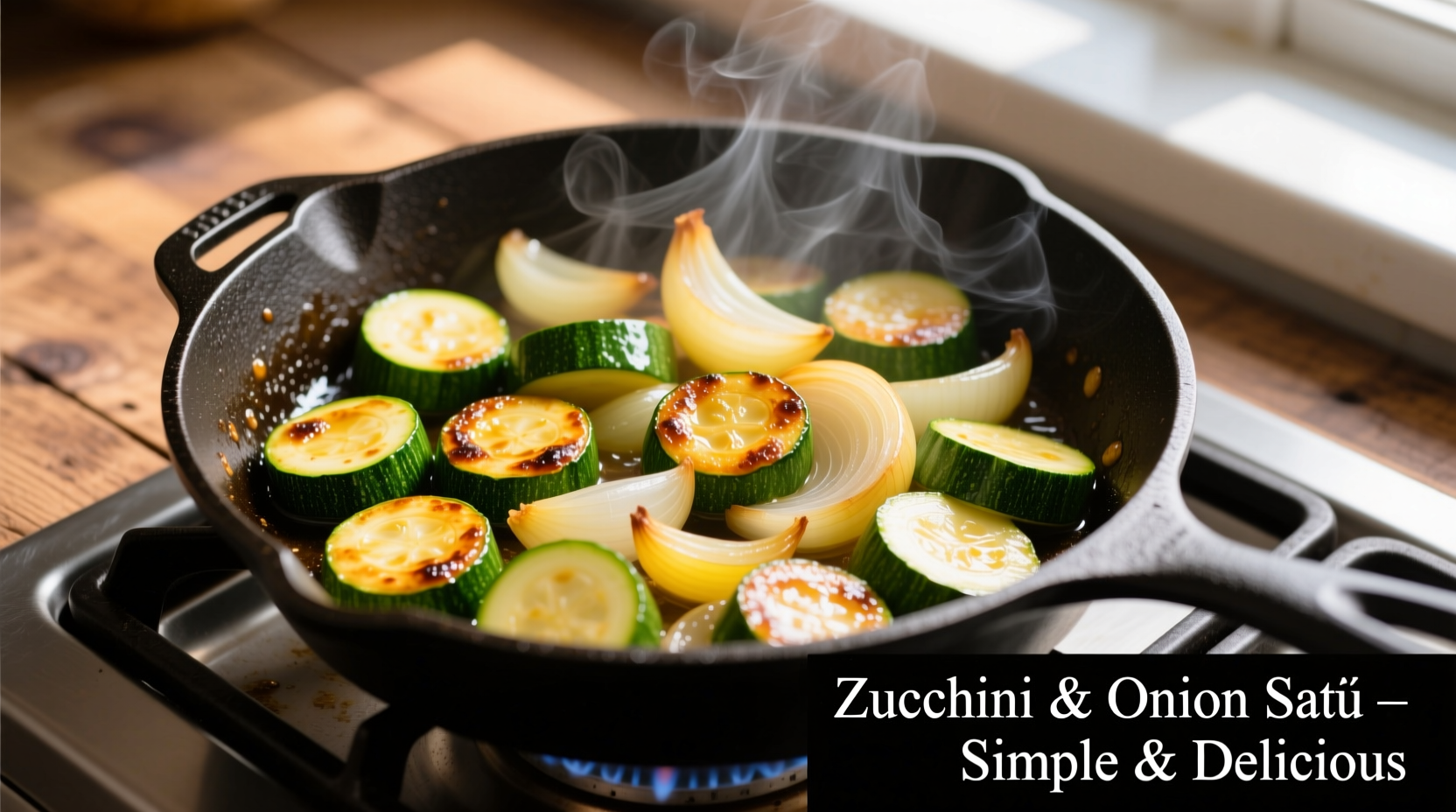A perfect zucchini onion sauté takes just 15 minutes to prepare, creating a flavorful side dish packed with nutrients. This simple recipe yields tender-crisp zucchini and caramelized onions that pair well with proteins, grains, or as a standalone vegetarian option. The key to success lies in proper heat management and timing - techniques that transform basic ingredients into a restaurant-quality dish.
Why This Sauté Method Works
Professional chefs rely on the sauté technique for zucchini because it preserves texture while developing complex flavors. Unlike boiling or steaming, sautéing creates the Maillard reaction - that delicious browning process that enhances natural sweetness without waterlogging the vegetables. The USDA Food Safety and Inspection Service confirms that proper sautéing maintains up to 90% of zucchini's vitamin C content compared to boiling which can leach out water-soluble nutrients.

Step-by-Step Cooking Process
Follow these precise steps for optimal results every time. The timing windows are critical - zucchini becomes mushy if overcooked by even 60 seconds.
Preparation Phase (3 minutes)
- Cut zucchini into uniform ¼-inch half-moons (thicker pieces won't cook evenly)
- Thinly slice onions into ⅛-inch crescents for proper caramelization
- Dry vegetables thoroughly with paper towels - moisture is the enemy of browning
Cooking Phase (10 minutes)
- Heat 2 tbsp avocado oil in cast-iron skillet over medium-high heat (375°F/190°C)
- Add onions first - cook 4 minutes until edges turn golden
- Add zucchini in single layer (crowding causes steaming)
- Cook undisturbed for 3 minutes to develop fond (those delicious browned bits)
- Flip and cook 2-3 more minutes until tender-crisp
- Finish with ½ tsp sea salt and fresh herbs
| Cooking Method | Texture Result | Nutrient Retention | Flavor Development |
|---|---|---|---|
| Sauté (proper technique) | Tender-crisp | 85-90% | Excellent caramelization |
| Boiling | Mushy | 40-50% | Minimal flavor development |
| Steaming | Soft but intact | 70-75% | Moderate flavor retention |
| Roasting | Crispy edges | 80-85% | Deep caramelization |
Avoid These Common Mistakes
Even experienced home cooks make these critical errors that ruin zucchini dishes:
- Salt too early - draws out moisture causing steaming instead of browning (add salt in final minute)
- Overcrowded pan - lowers temperature preventing proper sear (cook in batches if needed)
- Wrong oil selection - olive oil smokes at high temps (use avocado or grapeseed oil)
- Constant stirring - prevents fond development (let sit for 3 minutes before flipping)
When This Recipe Works Best (And Limitations)
This sauté method shines as a weeknight side dish but has specific context boundaries. According to culinary research from the Culinary Institute of America, sautéing works optimally for:
- Fresh summer zucchini (high water content requires quick cooking)
- Meals needing 15-minute preparation time
- Complementing grilled proteins like chicken or fish
It's less effective for:
- Winter storage squash (requires longer cooking)
- Dishes needing uniform soft texture (consider roasting instead)
- Meal prep beyond 3 days (zucchini deteriorates quickly)
Flavor Variations Worth Trying
Once you've mastered the basic technique, experiment with these professional variations:
Mediterranean Style
Add 2 minced garlic cloves in last 2 minutes of cooking plus 1 tbsp lemon zest and fresh oregano. Perfect with grilled lamb or as part of a mezze platter.
Asian Fusion
Substitute sesame oil for half the cooking oil and finish with 1 tsp rice vinegar and toasted sesame seeds. Pairs beautifully with teriyaki salmon.
Provençal Version
Incorporate 5-6 torn basil leaves and 1 tsp herbes de Provence during final minute. Serve alongside ratatouille or with crusty bread.
Nutritional Benefits You're Getting
This simple dish delivers impressive nutrition according to USDA FoodData Central analysis. One serving (1 cup) provides:
- 42% of daily vitamin C needs
- 28% of recommended manganese intake
- 3.2g dietary fiber (13% of daily value)
- Only 68 calories per serving
The American Heart Association notes that regularly consuming vegetables prepared with healthy fats like avocado oil improves absorption of fat-soluble vitamins while supporting heart health.
Serving and Storage Guidelines
For best results, serve immediately while vegetables maintain their ideal texture. If you must store leftovers:
- Refrigerate in airtight container for up to 3 days
- Reheat in dry skillet over medium heat (not microwave) to restore texture
- Do not freeze - zucchini becomes unpleasantly watery when thawed
- Revive leftovers with a splash of fresh lemon juice before serving
Perfect Pairing Suggestions
This versatile side complements numerous main courses:
- Grilled chicken with lemon-herb marinade
- Pan-seared salmon with dill sauce
- Eggplant parmesan for vegetarian meals
- As a topping for grain bowls with quinoa and chickpeas
Evolution of Sauté Techniques
The modern sauté method for delicate vegetables like zucchini has evolved significantly. Culinary historians note that traditional French techniques from the 19th century often overcooked vegetables. It wasn't until the nouvelle cuisine movement of the 1970s that chefs like Paul Bocuse championed the tender-crisp texture we expect today. Current best practices balance historical technique with modern understanding of vegetable chemistry - particularly how pectin breakdown affects texture at different temperatures.











 浙公网安备
33010002000092号
浙公网安备
33010002000092号 浙B2-20120091-4
浙B2-20120091-4